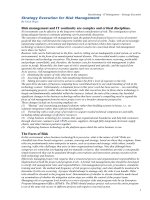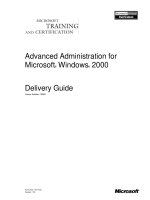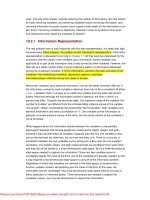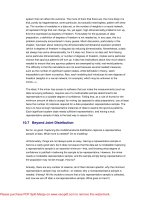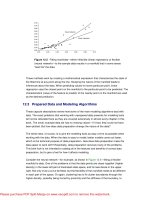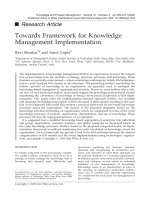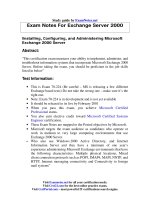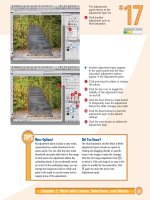Tài liệu Towards Framework for Knowledge Management Implementation ppt
Bạn đang xem bản rút gọn của tài liệu. Xem và tải ngay bản đầy đủ của tài liệu tại đây (283.85 KB, 19 trang )
&
Research Article
Towards Framework for Knowledge
Management Implementation
Ravi Shankar
1
* and Amol Gupta
2
1
Department of Management Studies, Indian Institute of Technology Delhi, Hauz Khas, New Delhi, India
2
GE Software Systems, Block A, First Floor South Wing, Cyber Gateways, HITEC City, Madhapur,
Hyderabad, Andhra Pradesh, India
The implementation of knowledge management (KM) in an organization involves the integra-
tion of knowledge from the domains of strategy, structure, processes, and technology. These
domains are generally underpinned—when assimilating roadmaps for holistic KM implemen-
tation—with standard KM models in the literature. The pioneering models manifesting the
holistic ‘growth’ of knowledge in an organization are generally used to underpin the
knowledge-based segregation of organizational structure. However, some authors take a criti-
cal view of such theoretical models, and instead suggest the knowledge process-based models
manifesting the ‘circulation’ of knowledge as being a more practical approach to KM imple-
mentation. This paper takes the implementation-oriented approach further, and modifies
and integrates the fundamental aspects of KM advocated in these models resulting in the crea-
tion of an integrated KM model that renders a practical framework for the broad knowledge
processes across the organization. The essence of the proposed integrated model are the
knowledge activities permeating an organization, which are categorized in terms of the cyclic
knowledge processes of creation, organization, dissemination, and use of knowledge. These
processes traverse the segregated structure of an enterprise.
It is suggested that a modified knowledge-based segregation of enterprise into individual
and group, organization, customer interface, and global enterprise be developed based on
the cyclic knowledge processes. Further, based on the proposed integrated model, an imple-
mentation framework is outlined manifesting the cyclic circulation of knowledge across the
organization. Such a framework can provide a link in the KM roadmaps between the abstract
categorizations in KM models and the actual implementations using technologies, organiza-
tions, and people. Copyright # 2005 John Wiley & Sons, Ltd.
INTRODUCTION
To remain competent in the increasingly competi-
tive global markets, enterprises must focus on a
strategy to better manage the knowledge that is
becoming their greatest asset. Effectively and
proactively capturing the dynamic customer
demands and reorganizing its production pro-
cesses and structure to meet these demands are
the primary attributes of a ‘learning organization.’
In addition, greater innovation in product develop-
ment and customer service entails an enhanced
emphasis on the management of knowledge.
Knowledge assets in an organization, in form of
the expertise of employees, production architec-
tures, and IT systems and corporate repositories
are considered the focal point for management of
knowledge.
Knowledge and Process Management Volume 12 Number 4 pp 259–277 (2005)
Published online in Wiley InterScience (www.interscience.wiley.com). DOI: 10.1002/kpm.234
Copyright # 2005 John Wiley & Sons, Ltd.
*Correspondence to: Dr. Ravi Shankar, Associate Professor,
Department of Management Studies, Viswakarma Building,
Indian Institute of Technology Delhi, Hauz Khas, New Delhi
110 016, India. E-mail:
The strategies for knowledge management
(KM) implementation in real world and in the
research landscape are related to ‘personalization’
and ‘codification’ of knowledge (Hansen et al.,
1999). In the personalization strategy, knowledge
is closely tied to the person who created it
and disseminated through person-to-person
knowledge sharing networks. In a codification
strategy, a knowledge object is developed by
removing customer or project sensitive informa-
tion and stored in repositories for later use. A
company deploys a combination of these strate-
gies focusing on one and using the other in a sup-
port function. Addressing the strategy, Mentzas
et al. (2001) suggested that a holistic conceptual
framework be created to provide a roadmap for
managers in ensuring integrity in KM implemen-
tation efforts. The roadmap suggests that success-
ful KM implementation is a truly holistic venture
that should leverage the knowledge assets and
employee networks by integrating the four aspects
of strategy, culture, processes,andKM system.The
generic roadmap for KM implementation is
outlined in Figure 1.
Figure 1 shows, as part of the generic strategic
plan for KM implementation, the knowledge assets
at the core that need to be integrated with the
knowledge sharing networks/activities. The design
and categorization of the knowledge sharing activ-
ities depends on the structure and processes of the
organization. These activities are generally struc-
tured at the level of individual, team, organization,
and interorganization as suggested by the archety-
pical segregated organizational structure and the
paradigm of ‘growth’ of knowledge in the organi-
zation (Hedlund and Nonaka, 1993). Similarly,
the knowledge processes related to creation, orga-
nization, dissemination of knowledge, etc. are gen-
erally accepted for managing the knowledge
sharing in organization. Establishing culture and
technological systems further enable the knowledge
sharing activities.
This paper focuses on the use of fundamental KM
models from literature to underpin the organiza-
tional structure and processes for KM implementation.
Wesuggestthattheaspects advocated in these funda-
mental models may not be absolutely appropriate for
KM implementation; rather, they may be molded to
a form more suitable during the implementation
phase. For this, we identify from literature the funda-
mental aspects of KM pertinent to the design of
knowledge processes and organizational structure
(Section Introduction). These aspects are modified
using a perspective oriented to sustaining knowledge
creation when implementing KM in the organization
(Section KM Models in Literature). The modified
aspects are then integrated with the objective of pro-
posing an integrated KM model that will be useful in
knowledge-based segregation of organizational
structure and the design of knowledge activities
and processes (Section Modified Perspective of
Fundamental KM Aspects). To provide a practical
linkage for the proposed model, the pragmatic
knowledge activities in an organization are then
categorized in accordance with the model (Section
Integrated KM Model). Finally, an implementation
framework is outlined using the proposed integrated
model to suggest future research direction for KM
implementation frameworks (Section Knowledge
Activities, Processes and Cycles).
KM MODELS IN LITERATURE
Many KM models with different approaches and
mindsets have been proposed in literature. McA-
dam and McCreedy (1999) have identified three
broad categories of KM models, namely knowledge
category models, intellectual capital models, and
socially constructed models.
1. Knowledge category models: These models advo-
cate categorization of knowledge into discrete
forms like codified and uncodified knowledge,
Assets
Group
Processes
Structure
Strategy
Individual
Interorganization
Organization
Systems
General strategic plan for
holistic KM implementation
Fundamental, theoretical
manifestation based on
paradigm of “growth and
expansion” of knowledge
Figure 1 General roadmap for holistic knowledge management (KM) implementation
RESEARCH ARTICLE Knowledge and Process Management
260 R. Shankar and A. Gupta
diffused and undiffused knowledge, tacit and
explicit knowledge (Nonaka and Takeuchi,
1995). Hedlund and Nonaka (1993) suggested a
significant categorization of organizational
knowledge that parallels the theoretical
organizational levels of individual, group, orga-
nization, and interorganization (customers, sup-
pliers, competitors). The model considers that
knowledge is shared through social interactions,
which begin at the individual level and then
‘grow and expand’ within the organization to
include groups and the whole organization
and finally transcend organizational boundaries.
That is, knowledge of individual becomes the
knowledge of group through knowledge sharing
among peers in the group. Group knowledge
then becomes organizational knowledge as the
best practices in one group are institutionalized
throughout the organization. This knowledge
further grows to interorganization level as it is
shared with collaborators and used to service
the customers.
2. Intellectual capital models:Thesemodelstreat
knowledge as an asset and segregate the organi-
zational knowledge in correspondence to its intel-
lectual assets. For example, intellectual capital can
be segregated into human, structural, and custo-
mer assets (Chase, 1997a; Roos and Roos, 1997).
3. Socially constructed models: These models discuss
KM focusing on the various knowledge pro-
cesses (Demerest, 1997). Demerest’s model
focuses on the knowledge processes in an orga-
nization such as the construction of knowledge,
embodiment of constructed knowledge, disse-
mination of the espoused knowledge, and
ultimately the use of knowledge for business
advantages in regard to organizational outputs.
The essence of these models is to identify
the simple flow of knowledge within and
across knowledge processes. The knowledge
processes may simply be characterized as crea-
tion, organization, dissemination, and use of
knowledge.
Apart from outlining these three categories
of KM models in literature, McAdam and McCree-
dy (1999) criticize the knowledge category and
intellectual capital models and suggest their inap-
propriateness with respect to KM implementation.
In turn, they advocate the socially constructed
models having a knowledge process-based
approach to have greater suitability for KM imple-
mentation. McAdam and McCreedy (1999) also cri-
ticize the knowledge processes-based (socially
constructed) Demerest (1997) model and augment
the model to highlight certain guidelines for future
research on implementation-oriented KM models.
These suggested guidelines are:
(i) to incorporate the recursive and circulatory
flow of knowledge across knowledge pro-
cesses,
(ii) to set up ‘use’ element for employee and
business and
(iii) to include both social and scientific aspects of
KM implementation.
These modeling aspects are reflected in Figure 2.
The figure outlines the knowledge processes of
creation, organization, dissemination, and use
of knowledge. It also shows the recursive flows of
knowledge between processes and certain aspects
important for KM implementation. The recursive
flows between processes represent the interactions;
for example, the process of knowledge organiza-
tion organizes the created knowledge, and doing
this recursively leads to improvement in the cre-
ated knowledge. The dotted plain arrow shows
the recursive flow of knowledge between creation
and use process as suggested by McAdam and
McCreedy (1999). We suggest a modification to it
in next section; the dotted arrow is to be replaced
by the modified arrow that is made bold to signify
it as primary factor for sustaining knowledge crea-
tion in the organization.
From these discussions, three fundamental
aspects of KM emerge from the literature: segre-
gated organizational domains, knowledge assets,
and knowledge processes. We propose a KM
model based on these aspects. However, a modi-
fied perspective to these fundamental aspects is
suggested by augmenting the corresponding stan-
dard KM models in the literature advocating
these aspects. The modified perspective aims at
molding the fundamental aspects to make them
more suitable for KM implementation. In keeping
with this approach, the discussions in the paper
become three-pronged. First, we present a
modified perspective of the KM aspects corre-
sponding to standard KM models in literature to
suit certain implementation and sustainability
criteria. Second, we integrate these implementa-
tion suited KM aspects to synthesize a proposed
integrated KM model. Finally, we propose a
framework for KM implementation underpinned
by the integrated KM model and use it to
suggest a research direction for the development
of KM systems; the coherence of framework to lit-
erature is also discussed in terms of the accor-
dance of the framework to the guidelines for
KM research as suggested by McAdam and
McCreedy (1999).
Knowledge and Process Management RESEARCH ARTICLE
Framework for KM Implementation 261
MODIFIED PERSPECTIVE OF
FUNDAMENTAL KM ASPECTS
The three fundamental aspects of KM and the cor-
responding standard models considered are: segre-
gated organizational domains by Hedlund and
Nonaka (1993) model, knowledge assets by Chase
(1997a) model, and knowledge processes model
by McAdam and McCreedy (1999) and Demerest
(1997). Table 1 shows this modified perspective in
comparison with the traditional perspective on
KM models.
The model by McAdam and McCreedy (1999)
advocates knowledge processes and recursive
flows between them; we augment the model to
emphasize a cycle of knowledge processes focusing
KNOWLEDGE
CREATION
KNOWLEDGE
DISSEMINATION
USE
KNOWLEDGE
ORGANIZATION
Scientific aspects Social aspects
Business benefits Employee ?
Figure 2 Cycle of knowledge processes in a process-based KM model
Table 1 Two perspectives on KM aspects
Traditional perspective on KM aspects Modified perspective on KM aspects
Traditional KM models Constituents Modified Integrated Constituents
KM aspects in literature KM aspects KM model
Knowledge
processes
Socially
constructed
models
Creation,
organization,
dissemination,
use
Cycle of
knowledge
processes
Socially
constructed
models
Creation,
organization,
dissemination,
use
Organizational
knowledge
segregation based
on ‘‘growth and
expansion’’ aspect
of knowledge
Knowledge
category models
Individual, group,
organization, inter
organization
(customers,
suppliers)
Segregation based
on cycles of
knowledge
processes
Knowledge
category models
Individual
and group,
organization,
suppliers,
customer
interface,
global enterprise
Knowledge assets Intellectual capital
models
Human,
structural,
customer
Knowledge assets
based on novel
organizational
segregation
Intellectual capital
models
Human,
structural,
customer, virtual
enterprise
RESEARCH ARTICLE Knowledge and Process Management
262 R. Shankar and A. Gupta
on sustaining knowledge creation. Incorporating
this cyclic approach in KM implementation sug-
gests a modified knowledge-based organizational
segregation reflected in the Hedlund and Nonaka
(1993) model. The resulting organizational segrega-
tion is followed to suggest corresponding segrega-
tion of knowledge assets. These views are
presented in the following subsections.
Cyclic knowledge processes
Nonaka (1991, 1994) emphasized the critical neces-
sity of sustaining the creation of knowledge in orga-
nizations. Employees are the primary sources of
innovations in an organization; however, there
are several other significant activities that may gen-
erate fresh knowledge. Knowledge managers iden-
tify and set up diverse activities aiming to sustain
knowledge creation. For example, incentives may
be set up to encourage the use of captured knowl-
edge; expertise in new domains may be developed
through recruitment; and valuable information
may be generated in repositories through techni-
ques like data mining (O’Leary, 1998b).
The activities relating to the use of existing
knowledge in the organization primarily support
the creation of new knowledge. Employees use
the learnings and experiences of their peers, from
related projects in past, in their current assign-
ments. In the process, they generate fresh mindsets
and knowledge pertinent to current projects.
Similarly, the mined customer-related data is ana-
lyzed for fraud detection, predicting future
demands of customers, etc. Organization uses cur-
rent and predicted future customer demands to
create flexibilities in their production architectures.
On basis of these observations—use of knowledge
significantly leading to the creation of new
knowledge—we propose a slight augmentation in
the knowledge processes-based approach sug-
gested by McAdam and McCreedy (1999).
Processes relating to the organization, dissemina-
tion, and use of knowledge bolster the knowledge
creation process through recursive flows of knowl-
edge. However, the recursive flow of knowledge
between the processes of knowledge use and crea-
tion is primarily responsible for generation of new
knowledge as compared to the recursive flow from
processes of organization and dissemination. The
augmented model is shown in Figure 2.
Bold arrows in the figure represent the principal
direction of knowledge flow while the plain arrows
represent recursive flows except that the recursive
arrow from use-process to creation-process (dotted
arrow) is replaced by bold to suggest that use of
knowledge primarily supports the creation of
new knowledge. This model highlights the impor-
tance of a cycle among the knowledge processes to
support sustaining of knowledge creation.
The cyclic approach to knowledge processes
effects an augmented segregation of knowledge-
based organizational domains in following subsec-
tion section.
Organizational structural segregation
The cyclic knowledge processes-based approach
tends to segregate a knowledge intensive organiza-
tion into different domains, categorized as follows:
individual and group,
organization (suppliers, collaborators, competi-
tors),
customer interface, and
global enterprise.
This proposed segregation differs from the funda-
mental knowledge-based segregation of organiza-
tion suggested by Hedlund and Nonaka (1993)
model:
individual,
group,
organization, and
interorganization (customers, suppliers, compe-
titors).
The first domain in the segregated organization
refers to an individual implicitly within his/her
group’s domain. To illustrate, in the process of
creation of knowledge individuals work towards
creation of fresh knowledge using their creativity,
or report exceptional experiences in day-to-day
work as part of the meetings organized by the
group heads. The group to which individuals
belong organizes this knowledge created by the
individuals in accordance to the standardized KM
processes. Processes are also set up to facilitate the
sharing of knowledge among peers in the group;
and this spurs the process of creation of new
knowledge if the individuals analyze and exploit
the available knowledge shared by peers in their
respective assignments. Therefore, to incorporate
a cyclic approach of knowledge creation in a team
the individual and his group need to be associated
together.
Two arguments may arise with this implicit con-
sideration of individuals in a group domain. First,
the explicit segregation level for individual in the
Hedlund and Nonaka (1993) model, and second,
the notion that cyclic knowledge processes can be
applied at individual level. Hedlund and Nonaka
(1993) model puts individual and group knowl-
edge in separate categories in accordance with a
Knowledge and Process Management RESEARCH ARTICLE
Framework for KM Implementation 263
theoretical view of ‘growth and expansion’ of
knowledge from the individual to his/her group
when individuals share their knowledge with the
group peers. Contending the arguments, our
approach associates individual together with the
group from the implementation point of view of a
manager who designs the knowledge processes.
The knowledge processes of creation, organization,
dissemination, and use in the context of individuals
are too unstructured to be simulated by KM imple-
mentation infrastructure; an implementation infra-
structure can, at most, support the knowledge
processes in individual domain. From the manage-
rial perspective, setting up incentives may spur the
knowledge processes of creation, dissemination,
and use in an individual domain when the indivi-
dual may create innovations, indulge in knowledge
sharing and use the knowledge feedback from
peers. From the technological perspective, Persona-
lization and Groupware technology can only support
the knowledge processes in the individual domain
by rendering relevant organization-wide knowl-
edge contextually to each employee in the organi-
zation. Therefore, combining the cyclic approach
with the implementation point of view suggests indi-
vidual to be just a part of a group.
Considering the next segregated domain, the
Hedlund and Nonaka (1993) model advocates sup-
pliers and collaborators working together with cus-
tomers at the interorganization level. However,
following the cyclic approach necessitates consider-
ing suppliers and collaborators at the organization
level. Such a view advocates assembling organiza-
tional knowledge together with the knowledge of
collaborators and suppliers in satisfying the
dynamic demands of customer (Sanchez, 2001b).
This kind of integration is most visible in the
internet-based digital markets where the product
needed by a particular customer may be assembled
from various suppliers depending on the specifica-
tions selected by the customer. The integration is
also evident in the increasing integration of suppli-
ers in the Enterprise Resource Planning (ERP)
implementations of companies. Consultants devel-
op KM solutions as a part of broader ERP (Skyrme,
1999; Shankar and Jaiswal, 1999).
Considering the next organizational domain, a
separate domain of organization may be perceived
explicitly for managing customer knowledge. This
is, in fact, evident in the modern business environ-
ments where organizations deploy IT applications
like Customer Relationship Management (CRM)
to develop a customer interface for managing the
customer knowledge. These applications simulate
the knowledge processes in context of customers
to manage the customer knowledge (Bose and
Suguraman, 2003). Moreover, these applications
are increasingly influencing the structure of the
organization (Tsui and Garner, 2000). IBM reengi-
neered its CRM process to integrate it with KM to
enable the integration of knowledge from the front-
end to the back-end (Massey et al., 2001). The inte-
grated model proposed in this paper will identify a
cycle of knowledge processes at the customer inter-
face.
Finally, a separate domain in the model is rea-
lized to enable enhanced sharing of knowledge in
a globally distributed enterprise. This is imperative
in the increasingly networked world. The global
enterprises have realized the importance of analyz-
ing the global market conditions to be able to fore-
cast possible future changes in their local and
global environments.
Summarizing, a cyclic approach to knowledge
processes groups individual and groups at the
same level from an implementation point of
view. It also groups the suppliers or collaborators
along with the organization at the organization
level. The importance of customer-related and
enterprise-wide knowledge suggests separate orga-
nizational segregation for each of these domains.
Considering the third fundamental aspect of KM,
knowledge assets are central to any KM implemen-
tation effort. Mentzas et al. (2001) suggest that,
in essence, KM is working to better manage the
content, quality, value, and transferability of
knowledge assets. We follow, in this paper, a
knowledge asset categorization corresponding to
the segregated domains of organization proposed
above.
Organizational knowledge assets
The organizational segregation proposed in the
previous section suggests the following component
assets of organizational knowledge:
a. knowledge in the form of experiences, expertise
of individuals and groups;
b. knowledge of organization that pervades its
production architectures involving knowledge
gathered from suppliers and collaborators;
knowledge embedded in the IT systems and
pertinent data warehouses and knowledge
bases;
c. knowledge regarding customers; and,
d. knowledge shared in a global enterprise.
This categorization of organizational knowledge
finds harmony with the categorization of intellec-
tual assets suggested by Chase (1997a): human
assets (knowledge, experience), structural assets
(processes, information systems), and customer
RESEARCH ARTICLE Knowledge and Process Management
264 R. Shankar and A. Gupta
assets (customer relationships, brands). In addition
to these assets, we have added the knowledge
shared across the virtual enterprise—that is,
technology-enabled knowledge sharing among
peer organizations across geographical bound-
aries—as a knowledge asset.
Summarizing the modified perspective on fun-
damental KM aspects derived from the literature
from an implementation point of view: a cyclic
approach to knowledge processes, aiming to sus-
tain knowledge creation, effects practical segrega-
tions of organization; be it be the knowledge
based segregation into individual and group, orga-
nization and suppliers, customer interface and glo-
bal enterprise or the segregation of its knowledge
assets into human, structural, customer, virtual
enterprise. This modified perspective is used to
evolve an integrated KM model that aims to render
an approach useful for the design of knowledge
activities and processes for implementing KM
across the organization.
INTEGRATED KM MODEL
The integrated KM model is developed to cater to
the practical aspects that managers may consider
while setting up the knowledge processes in an
organization. Some of these aspects relevant in
the context of this paper are stated. Generally,
knowledge-focused activities already exist in any
knowledge-enabled organization. Knowledge pro-
cesses may then be designed to clearly identify
these activities, enable them and organize them
for effective process integration. Apart from this,
managers need to design processes according to
the theories of KM in order to capture and store
knowledge from various assets and disseminate it
across various departments in the organization.
Moreover, the design of similar activity or process
may vary from one department to another
depending on the functionality and context in
which the knowledge is required. In these cases,
the process should be customized according to
the need(s) in the particular organizational domain.
On this basis, two guidelines are outlined for any
implementation-oriented KM model:
(i) the model should categorize the activities that
constitute knowledge processes, and
(ii) the model should categorize the processes
according to the different domains of the
organization.
To further develop the integrated KM model fol-
lowing these guidelines, the integration of the
implementation-oriented perspectives on KM
(knowledge assets, cyclic knowledge processes
and organizational segregation proposed in pre-
vious section) appear best suited. To show this,
these perspectives are analyzed using a pragmatic
bottom-up approach to set them as the attributes of
the integrated KM model (represented by the two
leftmost parts of Figure 6, discussed in later sec-
tion).
The most fundamental aspect of any organiza-
tional business is the hands-on activities performed
for the business. The hands-on activities relating to
KM are the pragmatic knowledge-focused activities
that infuse any knowledge-enabled organization.
The essence of knowledge-focused activities is
essentially the knowledge content that originates
in the various knowledge assets in the organiza-
tion. So, it seems obvious that the activities and
knowledge assets should be the elementary focus
area for any KM implementation effort. Thus, the
focus in this paper is on these activities and the
processes in which they are embedded.
Knowledge-focused activities permeate every
department of a knowledge-enabled organization.
These activities may be categorized under one
of the processes of creation, organization, dissemi-
nation, and use of organizational knowledge. In
addition, ideally, these activities should be designed
and arranged cyclically by process designers who
aim to effectively support and sustain the process
of knowledge creation. For example, managers
should set up mechanisms and incentives to pro-
mote reuse of knowledge captured in groups.
Thus, the proposed cyclic approach to knowledge
processes is appropriate in outlining one attribute
of the integrated KM model, that is, the categoriza-
tion of knowledge-focused activities in an organi-
zation.
In the broader context of knowledge processes
that embed the activities, the design of same type
of knowledge process may differ in different
domains/departments of the organization. For
example, in the individual and group domain the
process of organizing knowledge is designed with
aim of capturing day-to-day problematic issues
and pertinent improvisations to address these
issues carried by team members, while same pro-
cesses (relating to the organizing of knowledge) at
the company-wide level are designed with the aim
of capturing the learnings and experiences from
projects successfully completed by the company.
The difference in the design of the same processes
for organizing knowledge in the domains of group
and whole company respectively is due to the dis-
tinct characteristics of knowledge assets in these
domains; that is, tacit knowledge-based improvisa-
tions by team members at the group level, and
Knowledge and Process Management RESEARCH ARTICLE
Framework for KM Implementation 265
